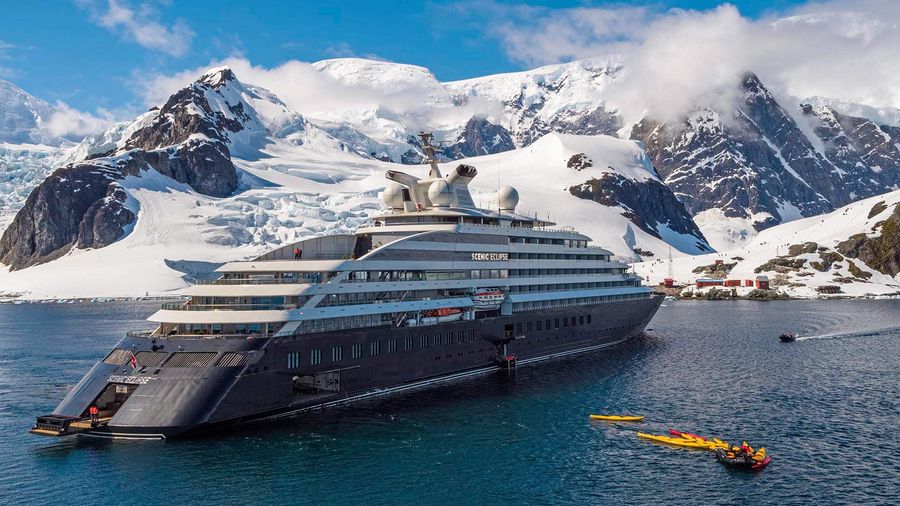Best destinations to discover in Antarctica – Crazy sexy fun traveler
29 Oct2022
About Antarctica
The South Pole is in the southernmost continent, Antarctica, which is also an ice-covered, mostly deserted landmass. The Antarctic Peninsula, which juts out into South America, is where most voyages to the region stop. It is well-known for the Lemaire Channel, a stunning waterway surrounded by icebergs, and Paradise Harbor, as well as Port Lockroy, a former British research facility turned museum. The secluded landscape of the peninsula is home to a variety of animals, including several penguins. And checkout more about Antarctica cruise on ponant.com
Facts you didn’t know about Antarctica
It can appear to be a typical island at first, but you should pay carefully since it is not totally covered in snow. The planet’s most southern active volcano is Mount Erebus, whose tip creates Ross Island. In the late 1960s, it last erupted.
Antarctica is not formally divided into time zones because the continent is primarily uninhabited and governed by an international body. The research stations decide whether to observe the time zone of the nation that sponsors them or the one that is physically nearest to their base (Chile for example).
A region is considered a desert if it gets less precipitation than 254 mm annually. Antarctica receives less than 50 mm of rainfall annually. In some areas of Antarctica, it has been almost 2 million years since there has been any snow or rain! Antarctica is the world’s driest continent and the world’s biggest desert. The Sahara should take precautions!
You could believe that the temperatures are far lower than what you can stand. However, cruises travel mostly to the northern section of the continent and stop in Antarctica from November and March, which is the southern hemisphere’s summer. Summertime temperatures in this region of the peninsula range from -2 °C to 2 °C. Woe to you if you decide to travel further south in the dead of winter. There, in 2010, -92 °C, the world’s lowest temperature, was measured.
Although you may assume that in such a frigid climate freshwater would freeze, Antarctica contains roughly 300 lakes. How is it even possible? Since they lie beneath, heat from the Earth’s core keeps their temperature above zero degrees.
Reptiles rely on environmental heat sources to stay warm since they have cold blood. They are unable to endure in a frigid environment like Antarctica. The lack of snakes means that the penguins can sleep soundly.
That is 75% of the freshwater in the globe. Underneath all this ice lie rocks and dirt; the continent is twice the size of Australia. Some of the icebergs are enormous in and of themselves; one of them has been found to be bigger than Jamaica. It is the biggest iceberg ever measured, covering 11,000 km2.
Every month offers a unique experience in Antarctica. Summer officially starts in November, when the icebergs are very large, and the birds are courting and mating. Penguins sit on their eggs in December. The eggs hatch in late December and early January. Whale sightings are more frequent in February and March, and the chicks undergo molting. The remainder of the year, Antarctica is closed to tourists since it is too cold and dark most of the time.

Scenic Eclipse Luxury Antarctica cruise
Best Destinations to discover & Things to see in Antarctica
One of the most popular destinations in Antarctica is the magnificent South Shetland Island, which is located 160 kilometers north of the Antarctic Peninsula. The island has some of the most amazing fjords and glaciers and is entirely covered in ice. Elephant seals and penguins, on the other hand, live along the rocky shores. All year long, eight different nations operate research stations on the islands, with King George Island hosting most of the stations. Deception Island, which is well-known for having a collapsed yet active volcanic cone, is one of the other well-known islands.
The most northern region of Antarctica is where a wide variety of polar fauna may be found. It consists of iceberg-strewn rivers and small channels that are frequently used by expedition cruises that make landings on remote Antarctic Peninsula islands and natural harbours. Visitors come to the peninsula for its spectacular beauty, which includes towering glaciers and vast sky. Along with being a scenic pleasure, the area is also known for its cormorant colonies and penguin rookeries. The migratory season presents a variety of chances to see minke, humpback, and killer whales up close.
Between South America and Antarctica, there is a long length of water in the passage that evokes both dread and adventure. Visitors to the area need to be mindful of the churning that the waves, gales, and excitement might induce in the stomach. Enjoy viewing massive albatrosses from the deck as you make your way to the intriguing courses on geography and animals. You are certain to never forget your first glimpse of the magnificent huge iceberg, a delight all its own, as you gently approach the icy continent.
The rich biodiversity of the Falkland Islands makes it one of the most well-liked tourist destinations in Antarctica. Due to its architecture and style, the island has some resemblance to Britain. The islands provide the finest birding experience combined with a broad variety of nesting locations and a significant number of marine species. Visitors may take in the sight of massive albatrosses flying overhead as well as four different types of penguins breeding on the coastline while taking an island tour. Explore the lifestyles and customs of others you meet in Port Stanley who live on the same island. Enjoy exploring Port Stanley, which offers a variety of fish and chip options, as well as red phone booths and other Antarctica-related sights.
The Alps, a long, slender island belonging to South Georgia, is situated in the middle of the Atlantic. The word “Alps” refers to the towering mountains that encircle much of the continent. Enjoy the most gorgeous areas in the area, including the imposing glaciers, dramatic fjords, and low-lying meadows. It is without a doubt one of the most popular destinations in the area because to the number of them. Due to the beaches where penguin and seal colonies thrive, the area is quite popular. The location is worth seeing because of the remnants of the whaling stations, which are picturesque. Due to the island’s accessibility, tourism has grown in popularity.
Without sailing through the breathtaking Lemaire Channel, a vacation to Antarctica is not complete. The region above the lake is dominated by glaciers, icebergs, and high cliffs. Humpback whales and behemoths are underneath these amazing creatures. Keep an eye out for orcas as you go to this breathtaking location. Due to the channel’s 1600-meter narrowness and abundance of loose icebergs, it is extremely dangerous. The scenery gives a stunning mirror perspective that is virtually a photographer’s dream, making it a photographers’ paradise.
One of the most visited locations is a natural harbour on Wiencke island’s northwestern side. The tourist attraction earns its place as one of Antarctica’s most sought-after tourist sites for a wide range of cruise ship passengers. This is a natural harbour that was formerly utilized for whaling and later used as a military outpost during World War II. The location quickly became a research station after this. A popular rest stop for tourists touring Antarctica, the port is now a historic monument with a post office and museum. Since only penguins are permitted to survive, half of Wiencke Island is now off limits to tourists.
This ice shelf, which is several hundred meters thick, is by far the biggest in Antarctica. The biggest floating body of ice, one of the most magnificent natural wonders in the world, is undoubtedly beautiful to look at. Ross Island is home to Mt. Erebus, an active volcano that rises 3,794 meters above sea level. The area is home to a wide variety of penguins, enormous glaciers, and several historical landmarks, making it a well-liked tourist destination in Antarctica.
Reasons to visit Antarctica
The perfect vacation is an expedition to Antarctica. These remote regions are difficult to reach and have a constantly changing landscape. Here are five justifications for embarking on an Antarctic voyage.
Antarctica is still one of the few places on earth that has been conserved and is far from popular tourist routes. Tourism is controlled. There are never more than 200 people on board a ship leaving towards the White Continent at once. Everyone has the chance to delight in a remarkable experience and make priceless memories.
Antarctica is a genuine haven for wildlife and is home to a variety of marine animals and migrant birds. Travelers may enjoy seeing Weddell seals, Minke whales, humpback whales, sea leopards, and subantarctic fur seals perform in the ocean. King penguins, gentoos, southern rockhoppers, and chinstraps, joined with albatrosses and petrels, bounce, and play to finish the performance both on the ground and in the air.
These picturesque scenes are set against a backdrop of blue icebergs, shimmering ice towers, a spotless ice floe, commanding mountain ranges, and glaciers that are thousands of years old. You’ll be mesmerized by the many tons of white, blue, grey, and even purple here. Ice takes on a flaming brilliance after sunset.Moments of unadulterated feeling are brought on by the environment’s sheer size and the “cacophony” of the elements.
For any adventurer at heart, the White Continent is the ultimate destination, and visitors won’t be let down when they see it in all its beauty. These are the top five highlights of an Antarctic cruise.
What does it indicate when the ominous digits “66°33” appear on the navigational instruments? Beyond the 66th parallel, in the heart of Antarctica, you are! It played a crucial role in Antarctica’s history when James Cook, a British explorer, made the first crossing in 1773. Travelers who emulate the great explorers will have a deep feeling of delight and achievement.
Icebergs, whether tabular, blocky, or pinnacled, all have a propensity to leave visitors dumbfounded. These ocean giants are beyond description! Their shapes rise with the waves and dive deep into the ocean with a colorful combination of thousands of colors of blue, from light turquoise to the darkest navy, all glistening beneath the chilly sun of Antarctica. They are both beautiful and unsettling.
New Zealand’s subantarctic islands are among the few places on Earth that are entirely unaffected by human presence and are totally maintained. Some of these teeny-tiny islands scattered throughout the ocean are unreachable and so completely uninhabited. Thus, for the indigenous species that call the Snares Islands, Bounty Islands, Antipodes Islands, Auckland Islands, and Campbell Islands home, including 126 bird species, they serve as a priceless refuge of tranquilly.






